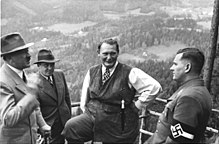Tea house on the Mooslahnerkopf

The Teehaus am Mooslahnerkopf or Teehaus am Moslanderkopf was a tea house on the Mooslahnerkopf for Adolf Hitler in the Führer's restricted area Obersalzberg .
history
After the architect Roderich Fick had converted the Wachenfeld house into a Berghof for Hitler in 1936 , Martin Bormann commissioned him to build the tea house on Mooslahnerkopf not far from the domicile on Obersalzberg . In the catalog raisonné , however, it is listed as a tea house on the Moslanderkopf as well as in the architectural plans and also in the memoirs of Eva Braun.The cylindrical tea house was then built in 1937 and was Hitler's favorite excursion destination , which he used extensively in contrast to the Kehlsteinhaus . On April 25, 1945, the area on Obersalzberg was attacked by the Royal Air Force. The tea house probably received no hit. The house was then destroyed by the Americans in 1951–1952 and dismantled to prevent a memory of Hitler.
The remains, which were near a golf course, were finally removed in August 2006 after the construction of the InterContinental Berchtesgaden Resort .
Location and appearance
The tea house was built directly on the slope, a foothill of the Hohe Göll . The central circular building had a diameter of 9 meters and was illuminated by three large windows, which also allowed a limited panoramic view of the Berchtesgaden valley basin . Power supply, water connection and sewerage had also been thought of. The entrance to the round tea house was on the slope side. In the center was a circular table, around which upholstered armchairs were arranged. There was additional seating around the central furniture. An approx. 12 meter long, hexagonal farm building was attached to the rotunda. In the further area - not hidden in the surrounding forest for the guests - there were splinter protection cells and buildings for the guards.
Web links
Individual evidence
- ↑ Roderich Fick. In: arch INFORM . (List of works)
- ↑ a b c d e James A. Yannes: The Encyclopedia of Third Reich Tableware . Trafford Publishing, 2013, ISBN 978-1-4669-9985-5 , pp. 602 (English, 638 p., Limited preview in Google book search).
- ↑ Obersalzberg 1933–1945 , page 3 (PDF; 217 kB) Maik Kopleck, Ch. Links Verlag, 2005, ISBN 978-3-86153-355-9
- ↑ Teehaus on the Mooslahnerkopf
- ↑ The secrets of the Alpine fortress
- ^ Franz Wilhelm Seidler, Dieter Zeigert: The Führer Headquarters: Systems and Planning in the Second World War . 2nd Edition. Herbig, Munich 2000, ISBN 3-7766-2154-0 , pp. 261 (383 p., Limited preview in Google Book search).
Coordinates: 47 ° 38 '22.4 " N , 13 ° 2' 11.8" E